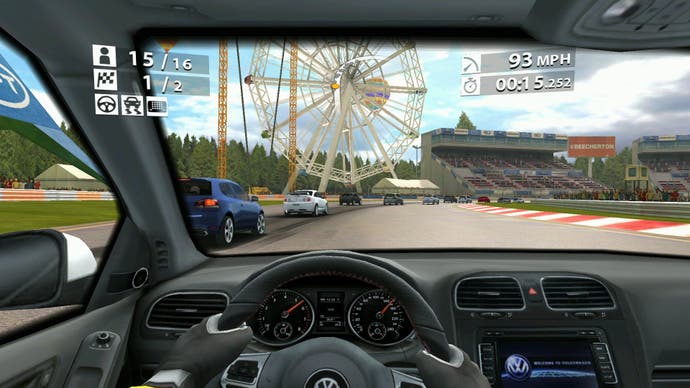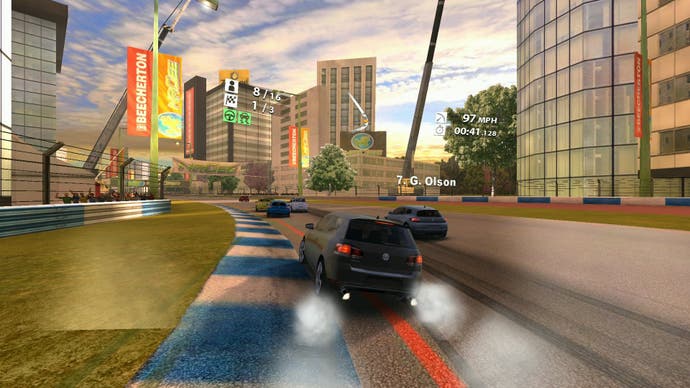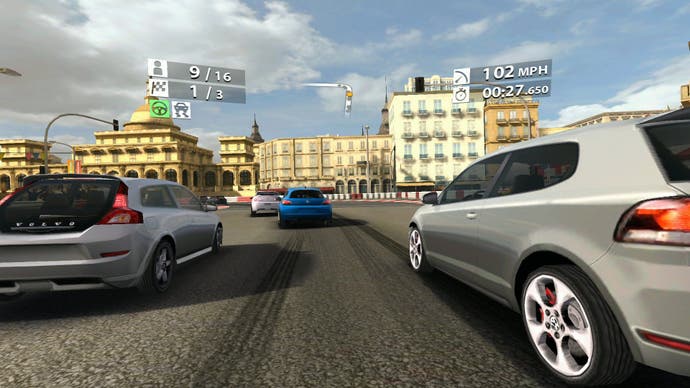Real Racing 2 HD: 1080p comes to iOS
iPad 2 establishes a new mobile benchmark.
A fever pitch of speculation surrounded the recent launch of iPad 2, with Apple managing to keep a tight lid on the technical make-up of the new device right up to the launch event. There we saw Epic Games' excellent Infinity Blade showcased with a level of performance and graphical finesse that outstripped the same game running on the original version of Apple's tablet.
While it's clear that Epic was given access to prototype versions of the new device, most developers were left as much in the dark as the rest of us. Even basic info on the specs of the revamped machine was carefully guarded, presenting some serious challenges to developers champing at the bit to support the new hardware from launch.
Flight Control developer Firemint was especially eager to brings its new racing sequel, Real Racing 2 HD, across to iPad 2 as quickly as possible.
"In anticipating the iPad 2 release, we were actually working with a matrix of different possibilities for what it might be. As time went by and we heard rumours we would adjust the probabilities in each configuration," Firemint CEO Rob Murray tells us.
"We worked on basically two versions for iPad 2. One was built for about 25 per cent to 50 per cent performance increase, the other was the 'hit it out of the park' kind of performance increase. When we saw the keynote we switched gears rapidly to the 'hit it out of the park' version that meant that we were finishing off a new graphics set that we had been working on."
The Firemint team's most optimistic projections still turned out to be somewhat conservative in comparison to the performance of the final device, and bonus goodies could be added to the graphical mix without impacting performance. Apple had surprised many people by not going for a modest GPU upgrade for the new A5 processor, instead choosing a powerful dual-core PowerVR SGX535.
"The iPad 2 hardware allows us to run the game fully anti-aliased with a much higher polygon count and texture resolution at a higher frame-rate with numerous extra effects turned on," Murray enthuses.
"The original iPad's specifications don't allow for these improvements. However, we've found ways of making it look great on the older hardware. If it was possible to run the exact iPad 2 code on iPad 1 then it would run very, very slowly. Once you have seen 1080p output running, I think you would agree with Apple's estimate of 9x performance increase in graphics."
Yes, you read that correctly - Firemint has implemented 1080p native resolution on a mobile video game. Last week, Real Racing 2 HD was updated to support full HD video output using the new digital video HDMI dongle Apple released alongside iPad 2. The Australian developer reckons it has achieved a consistent 30 frames per second output from the new hardware, running gameplay on the HDTV with circuit and telemetry data displayed on the tablet itself.
Of course, the mooted performance level is something we can put to the test with our bespoke capture equipment and tools, while demonstrating the quality of visuals Firemint has achieved while operating at this resolution.
Based on this analysis, Firemint lives up to its claims - but one thing that is curious about the general performance level is that while 30 unique frames are indeed being generated each second, the video output does not follow the usual cadence of unique frames being followed directly by duplicate frames in a 60Hz output.
Instead, we see bunches of unique and dupes grouped together, resulting in motion that doesn't appear as fluid as a truly locked 30FPS title such as the HD console versions of Need for Speed: Hot Pursuit or Fight Night Champion. The fact that we see the same unevenness in other iOS titles such as Infinity Blade and Rage HD (even running on iPad 2) suggests that the issue here may not be down to the developer.
Regardless, the technical accomplishment is clear. There's no doubt about it: while the anti-aliasing may be gone, this is indeed a native 1920x1080 framebuffer in operation, running at an exemplary frame-rate for a mobile game. On top of that, like all the iOS titles we've seen thus far, its v-sync is enabled too.
"Actually, the game will support both 1080p and 720p through HDMI, but the full HD version (1080p) got us the most excited," says Murray.
"Plus, we wanted to go a step beyond what your typical console game provides - there aren't a lot of current-gen titles out there that run naturally at 1080p without upscaling. The game doesn't just drive the 1920x1080 display on the TV, but it also runs its own 1024x768 screen at the same time. That's a lot of pixels!"




The technological upgrades in iPad 2 are all the more welcome bearing in mind that the first version of the tablet exhibited issues in running certain games, sometimes running with a performance deficit in comparison to the iPhone 4 and fourth-gen iPod Touch.
All three devices use Apple's A4 processor, but the iPad needs to service a 1024x768 resolution compared to the 960x640 Retina display - that's an additional 28 per cent fill-rate the SGX535 has to find from somewhere. This led to a delay in the release of Real Racing 2 HD.
"If we could have had the iPad 1 version of Real Racing 2 ready for Christmas, we would have launched it at Christmas. So yes, it is right to speculate that we were having trouble with the build on that device. The challenge for us was that with the bigger screen you can see more detail and you also require a higher frame-rate," Murray explains.
"So for the graphics on iPad to be perceived as equivalent in quality to the iPhone 4 it wasn't enough to just get the game so that it could run the same game at the same speed on the iPad. We actually had to speed the game up significantly at the same time as adding even more detail."


